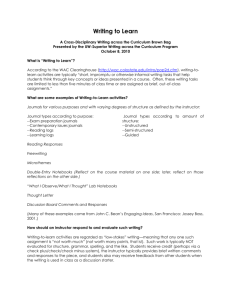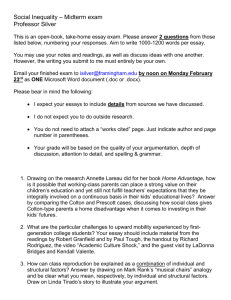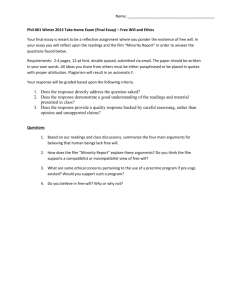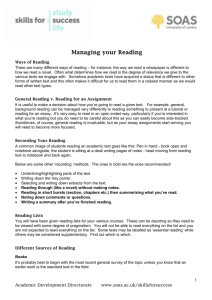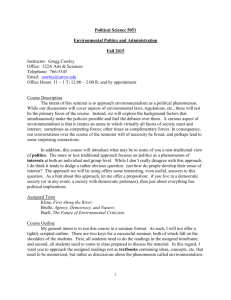handout
advertisement
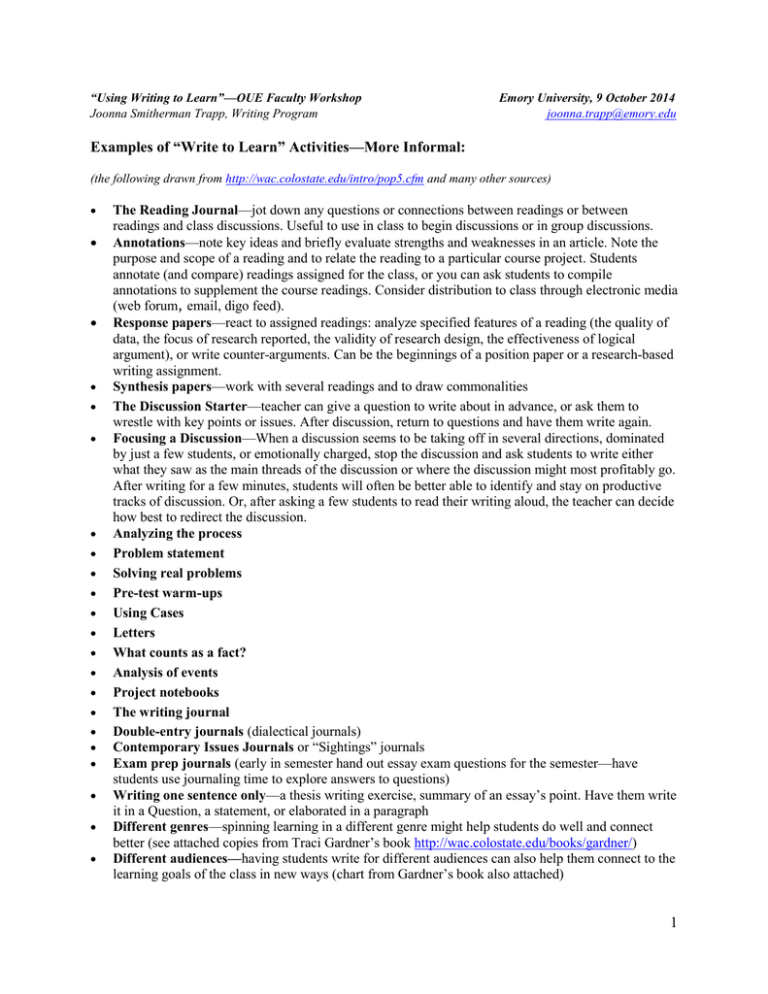
“Using Writing to Learn”—OUE Faculty Workshop Joonna Smitherman Trapp, Writing Program Emory University, 9 October 2014 joonna.trapp@emory.edu Examples of “Write to Learn” Activities—More Informal: (the following drawn from http://wac.colostate.edu/intro/pop5.cfm and many other sources) The Reading Journal—jot down any questions or connections between readings or between readings and class discussions. Useful to use in class to begin discussions or in group discussions. Annotations—note key ideas and briefly evaluate strengths and weaknesses in an article. Note the purpose and scope of a reading and to relate the reading to a particular course project. Students annotate (and compare) readings assigned for the class, or you can ask students to compile annotations to supplement the course readings. Consider distribution to class through electronic media (web forum, email, digo feed). Response papers—react to assigned readings: analyze specified features of a reading (the quality of data, the focus of research reported, the validity of research design, the effectiveness of logical argument), or write counter-arguments. Can be the beginnings of a position paper or a research-based writing assignment. Synthesis papers—work with several readings and to draw commonalities The Discussion Starter—teacher can give a question to write about in advance, or ask them to wrestle with key points or issues. After discussion, return to questions and have them write again. Focusing a Discussion—When a discussion seems to be taking off in several directions, dominated by just a few students, or emotionally charged, stop the discussion and ask students to write either what they saw as the main threads of the discussion or where the discussion might most profitably go. After writing for a few minutes, students will often be better able to identify and stay on productive tracks of discussion. Or, after asking a few students to read their writing aloud, the teacher can decide how best to redirect the discussion. Analyzing the process Problem statement Solving real problems Pre-test warm-ups Using Cases Letters What counts as a fact? Analysis of events Project notebooks The writing journal Double-entry journals (dialectical journals) Contemporary Issues Journals or “Sightings” journals Exam prep journals (early in semester hand out essay exam questions for the semester—have students use journaling time to explore answers to questions) Writing one sentence only—a thesis writing exercise, summary of an essay’s point. Have them write it in a Question, a statement, or elaborated in a paragraph Different genres—spinning learning in a different genre might help students do well and connect better (see attached copies from Traci Gardner’s book http://wac.colostate.edu/books/gardner/) Different audiences—having students write for different audiences can also help them connect to the learning goals of the class in new ways (chart from Gardner’s book also attached) 1 Examples of Write to Learn Activities—More Formal: (drawn from John Bean’s Engaging Ideas and other sources) Micro-Theme papers-- usually less than 250 words, problem-based rather than task-based Believing and doubting—from Peter Elbow’s work. Students first write in support (believing a claim, then write negatively about it (doubting). Reflection Paper Writing Genres/Audiences—works well here too. Can be more involved and longer A poem from the perspective of a schizophrenic or other personality type that might seem foreign to the student A dialog between two historical figures on opposite sides of a conflict or debate A monologue from someone they might have interviewed for a project for information Rewrite the ending or beginning of a novel or story and reflect on what that does to the text A podcast in response to a scholarly essay the class has discussed. A myth or parable to express a philosophical or moral choice or cultural ideal An autobiography or process journal to show development in thinking in an area Consider adding performances of writing to your class—presentations, digital representations, etc., as another kind of writing Multimodal Small Writings: Check out our “Domain of One’s Own” for various digital tools and resources for ideas about how to incorporate designing and writing into your class. Consider adding your class to the list of Domain classes by adding a multimodal project(s). http://docs.emorydomains.org/resources/list_of_digital_tools. Also see a list of assignments with descriptions here http://docs.emorydomains.org/faculty/assignments. Primary Evidence Remix Participatory Politics Advancing Multilingualism Blogs, Twitter, social media Digital Portfolios Maps Digital Storytelling & Ethnographies Tactical Media Presentations Games Textual analysis Disciplinary helps—using W2Learn in your field: Foreign Language Studies—a research report on this very topic can be found at http://writing.umn.edu/isw/assets/pdf/publications/Homstad_Thorson96.pdf outlining the benefits of such activities as freewrites, word fields (associating word groups), word visuals (bubbles, cartoons), dialogs, notes, letters, descriptions, and many other ideas. Economics—a brief paper on this topic can be found at http://wac.colostate.edu/journal/vol1/gregor.pdf outlining such activities as freewrting, thought 2 questions, question/suggestion box, letters home, MICROSIM reports, journals, and essay exams which require summation of readings. Another source for example of adding quantitative writing can be found at http://serc.carleton.edu/sp/carl_ltc/quantitative_writing/quantitative_wr.html. Mathematics— http://wac.colostate.edu/journal/vol9/russek.pdf STEM disciplines— http://wac.colostate.edu/stem/db/ and also available is this scholarly report http://www.lifescied.org/content/11/1/17.full Sociology— http://www.sagepub.com/upm-data/3023_McKinneynote.pdf If you need assistance or someone to think with about enhancing your particular course with writing to learn activities, please feel free to contact the faculty and staff of the Writing Program. We would be happy to help in any way we can. Joonna Trapp joonna.trapp@emory.edu Dave Fisher d.d.fisher@emory.edu (First-Year Writing) David Morgen david.morgen@emory.edu (Domain of One’s Own) Mandy Suhr-Sytsma mandy.sue.suhr-sytsma@emory.edu (Writing Center) 3
